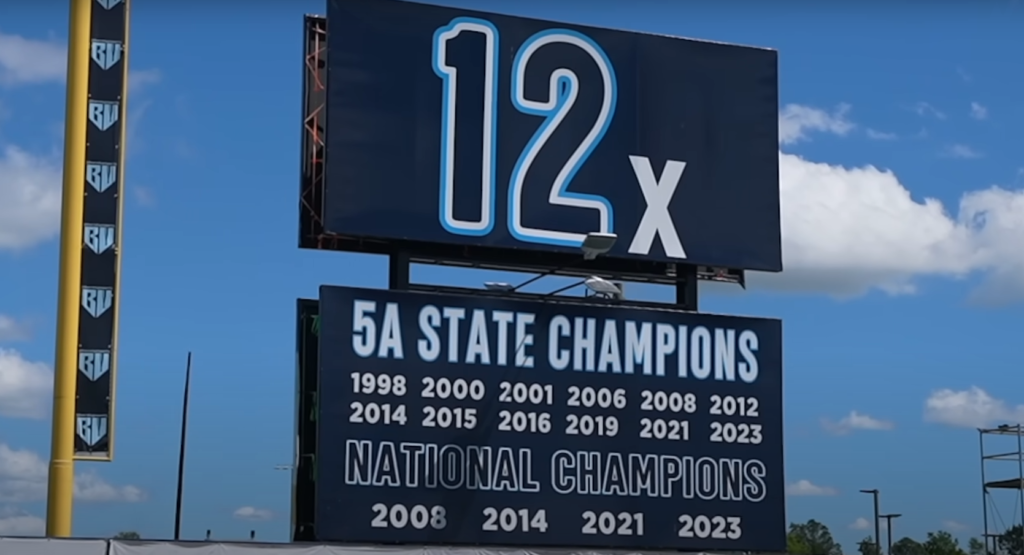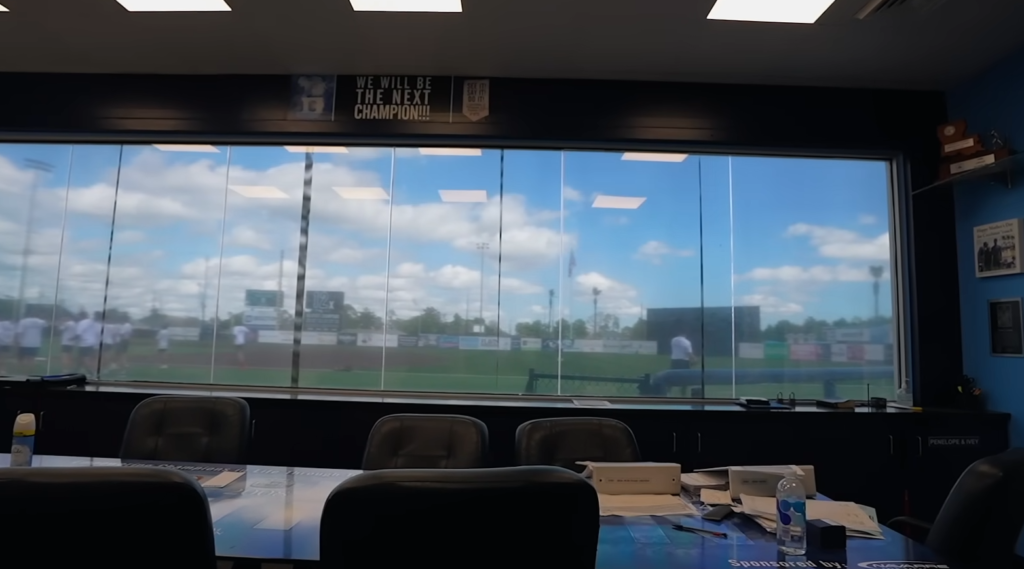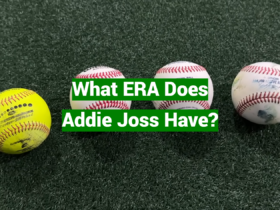In the heart of Friday night lights, where young arms sling fastballs and dreams soar beyond the outfield fence, the earned run average (ERA) reigns supreme as a pitcher’s ultimate badge of honor. But in the dynamic landscape of high school baseball, where competition varies, talent blossoms at its own pace, and every game feels like a mini-drama, deciphering “good” from “bad” in the world of ERAs isn’t always a clear-cut call.
Is a sub-2.00 ERA reserved for mythical aces, or can a determined sophomore with a 4.50 still lead his team to victory? Unveiling the mysteries behind this coveted statistic, this article delves into the nuances of ERA in high school baseball, exploring what truly defines a “good” number, how context shapes its meaning, and ultimately, empowering you to appreciate the grit, skill, and sometimes, a touch of luck, that goes into every earned run allowed (or brilliantly prevented) on the diamond.
So, grab your peanuts, settle into the bleachers, and prepare to have your understanding of high school pitching ERA elevated to a whole new level!
Table of Contents
Who Invented the ERA Stat?
The ERA statistic is attributed to Earnshaw Cook, an American statistician and baseball enthusiast. Cook, born in 1912, made significant contributions to the statistical analysis of baseball during the mid-20th century. His groundbreaking work on baseball statistics was crystallized in his 1966 book, “Percentage Baseball.”
In “Percentage Baseball,” Cook introduced the concept of the Earned Run Average as a metric to assess a pitcher’s effectiveness. He proposed this statistic as a refinement to the traditional runs allowed per game, aiming to provide a more accurate representation of a pitcher’s performance by accounting for the quality of defense behind them.

Cook’s formula for ERA closely resembles the one used today:
ERA= (Innings Pitched/Earned Runs Allowed) ×9
This formula, designed to be calculated per nine innings pitched, allows for a standardized measure across different pitchers and game lengths.
Cook’s work marked a pivotal moment in baseball statistics, introducing a more nuanced metric that separated earned runs from unearned runs, recognizing the impact of defensive performance on a pitcher’s overall effectiveness. His contribution laid the foundation for the widespread use of ERA as a key indicator in evaluating pitchers.
It’s essential to acknowledge that while Cook formalized the ERA statistic, the concept of earned runs and their significance in evaluating a pitcher’s performance existed before him. The gradual evolution of baseball statistics, driven by enthusiasts like Earnshaw Cook, has enriched the game’s understanding and provided fans, analysts, and teams with valuable tools to assess player capabilities.
ERA Explained: The Essence of Earned Runs
At its core, ERA is a metric designed to quantify a pitcher’s effectiveness in preventing opponents from scoring runs. It is a key indicator of a pitcher’s skill, often used to compare players across different teams and eras. The concept of earned runs dates back to the early years of baseball, but the formalization of ERA as a statistical measure came about in the early 20th century.
The concept of earned runs is grounded in the idea that not all runs scored against a pitcher are entirely their fault. Unearned runs, caused by errors committed by fielders, are excluded from the calculation. The true measure of a pitcher’s prowess lies in the earned runs they allow, which gives a more accurate representation of their performance.
ERA Formula: Decoding the Numeric Alchemy
The ERA formula is deceptively simple but holds profound implications for a pitcher’s reputation. Calculated per nine innings pitched, the formula is as follows:
ERA = (Innings Pitched/Earned Runs Allowed) ×9
This straightforward calculation, however, conceals the intricacies involved in determining earned runs. To further understand the formula, we need to explore the four scenarios that can impact a pitcher’s ERA.

4 Scenarios that Impact ERA
1. The Following Pitcher’s Performance
A pitcher with a low ERA is often considered a linchpin of their team’s success. It reflects their ability to stifle opponents, minimize mistakes, and keep the game within reach for their offense. Conversely, a high ERA may suggest struggles on the mound, possibly due to a lack of command, susceptibility to hits, or an inability to strand baserunners.
2. Bad Fielders: The Hidden Variable
While the ERA primarily reflects a pitcher’s performance, the quality of fielding behind them can significantly influence the earned runs count. Errors committed by fielders allow unearned runs, which, although not directly attributed to the pitcher, can tarnish their ERA. This brings into play the importance of a strong defensive lineup to support a pitcher’s efforts.
In a scenario where a pitcher consistently faces defensive lapses, their ERA might not accurately represent their true skill level. Recognizing this, baseball analysts often look beyond ERA to metrics like Fielding Independent Pitching (FIP), which attempts to isolate a pitcher’s performance from the impact of defense.
3. Wild Pitch: Unleashing Chaos
The wild pitch is a wild card in the ERA calculation. A pitcher’s ability to control their pitches, preventing them from reaching the backstop or eluding the catcher’s grasp, is crucial. A wild pitch that allows a runner to advance and eventually score can elevate a pitcher’s ERA, even if they are not directly responsible for the run.
Pitchers with a propensity for wild pitches might see a skewed ERA, as their runs allowed may not entirely reflect their pitching skill. Coaches and analysts need to consider these additional factors when evaluating a pitcher’s overall effectiveness.

4. Passed Ball: Catcher’s Dilemma
Similar to wild pitches, passed balls are another factor that can impact a pitcher’s ERA. A passed ball occurs when the catcher fails to control a pitch that should be caught with ordinary effort, allowing baserunners to advance. While passed balls are attributed to the catcher, they can indirectly contribute to the pitcher’s earned runs.
A pitcher working with a catcher prone to passed balls might find their ERA affected by factors beyond their control. This highlights the interconnectedness of players on the field and the importance of considering the entire defensive unit when assessing a pitcher’s performance.
Is ERA A Good Metric For Evaluating Pitchers:
Designated Hitters: A Variable Impact
One of the longstanding debates in baseball revolves around the use of designated hitters (DH) in the American League. The presence of a DH alters the dynamics of the game, particularly when evaluating a pitcher’s performance. Traditionalists argue that pitchers in the National League, who must wield a bat, face a different set of challenges compared to their American League counterparts who can focus solely on pitching.
When considering ERA, this debate gains prominence. Should a pitcher’s ERA be evaluated in isolation, or should it be adjusted to account for the DH factor? Proponents of adjusting ERA argue that facing a designated hitter can be more challenging than confronting a pitcher at the plate, potentially impacting a pitcher’s ability to prevent runs.
On the other hand, purists argue that ERA, in its raw form, should stand as a testament to a pitcher’s overall performance, reflecting their prowess on the mound regardless of the league’s designated hitter rule.
Relief Pitchers: Unraveling the Bullpen Mystery
ERA, calculated over nine innings, often faces scrutiny when applied to relief pitchers. Unlike starting pitchers who have a more predictable workload, relief pitchers operate in a dynamic environment where they might face a single batter or navigate through multiple innings [3].
The challenge arises in determining how to fairly evaluate a relief pitcher’s ERA. One dominant outing might significantly lower their ERA, while a single bad inning could inflate it disproportionately. Critics argue that evaluating relievers based solely on ERA may not provide a complete picture of their consistency and impact.
Sabermetricians have proposed alternative metrics, such as “Adjusted ERA” or “Leverage Index,” to account for the specific challenges faced by relief pitchers. These metrics aim to contextualize a relief pitcher’s performance, considering the situations they encounter and the pressure they endure.

Ballpark Location: The Impact of Home Field
ERA, as a standalone metric, may not fully capture the influence of a pitcher’s home ballpark on their statistics. Ballpark dimensions, altitude, and atmospheric conditions can vary significantly, leading to fluctuations in a pitcher’s ERA.
Pitchers in hitter-friendly ballparks might see their ERAs affected, as the likelihood of home runs and extra-base hits increases. Conversely, those in pitcher-friendly environments might benefit from lower run-scoring environments, potentially skewing their ERA lower than their actual performance merits.
To address this, analysts often consider metrics like “Park-Adjusted ERA” or “ERA+” to account for the impact of a pitcher’s home ballpark. These metrics aim to standardize ERA by factoring in the peculiarities of different ballparks, providing a more accurate representation of a pitcher’s true skill level.
Sabermetrics and ERA: A Complex Relationship
The advent of sabermetrics has revolutionized the way we evaluate baseball players, introducing a multitude of advanced statistics that delve deeper into player performance. While ERA remains a staple, sabermetrics enthusiasts argue that it should not be viewed in isolation.
Metrics like Fielding Independent Pitching (FIP), xFIP (expected FIP), and SIERA (Skill-Interactive ERA) provide alternative perspectives on pitcher performance. FIP, for instance, focuses solely on the events a pitcher can control – strikeouts, walks, hit-by-pitches, and home runs – removing the impact of fielding from the equation.
Sabermetrics suggests that while ERA is valuable, it may not always tell the whole story. A pitcher with a high ERA but a low FIP might be victimized by poor defense, while a low ERA coupled with a high FIP might indicate a pitcher benefiting from exceptional defense.

The Peculiarities Of High School Baseball
A breeding ground for future stars, a stage for teenage dreams, and a realm with its own unique set of quirks and characteristics. Let’s delve into some of the peculiarities that make high school baseball so special:
On the Field:
- The Pressure Cooker: Unlike professional leagues, high school baseball players are often juggling academics, extracurriculars, and social lives on top of their athletic commitments. This creates a unique pressure cooker environment where every game feels like it matters immensely;
- Uneven Competition: With varying budgets, coaching philosophies, and talent pools, the competition in high school baseball can be uneven. You might see a powerhouse team facing a ragtag group of underdogs, creating unpredictable and sometimes lopsided outcomes;
- The Showcase System: With scouts lurking in the stands, high school baseball becomes a showcase for young talent. This can lead to individualistic play, as players prioritize flashy performances over team-oriented strategies;
- The Unsung Heroes: Beyond the star pitchers and sluggers, high school baseball thrives on the contributions of unsung heroes – the defensive wizards, the bunts specialists, and the vocal leaders who keep the team spirit high;
- The Emotional Rollercoaster: From the elation of a walk-off win to the agony of a last-inning defeat, high school baseball evokes a powerful range of emotions that leave a lasting impact on players, coaches, and fans alike;
Off the Field:
- The Community Vibe: High school baseball games often become community events, drawing families, friends, and alumni together to cheer on their local team. This creates a unique atmosphere of shared passion and support;
- The Tradition: Steeped in history and tradition, high school baseball programs often have their own rituals, rivalries, and legendary figures that contribute to a rich cultural tapestry;
- The Learning Ground: Beyond the wins and losses, high school baseball serves as a valuable learning ground for young athletes. They develop teamwork, discipline, sportsmanship, and resilience – skills that extend far beyond the baseball diamond;
- The Uncertain Future: For many players, high school baseball is a stepping stone to bigger dreams. The uncertainty of college scholarships, professional drafts, and future opportunities adds another layer of intrigue to this stage of their athletic journey;
- The Nostalgia Factor: For many, high school baseball holds a special place in their memories. Years later, the echoes of cheers, the sting of defeat, and the camaraderie of teammates remain vivid reminders of youth, passion, and growing up;
These are just a few of the many peculiarities that make high school baseball such a captivating and enduring sport. It’s a microcosm of life, filled with challenges, triumphs, and lessons learned, all played out on a diamond under the Friday night lights.

Useful Statistics for the High School Baseball Coach:
1. Earned Run Average (ERA)
The cornerstone of pitching performance, ERA represents the earned runs allowed per nine innings. While valuable, it can be misleading, failing to account for unearned runs due to errors.
Beyond the Surface: Look at Fielding Independent Pitching (FIP), which isolates a pitcher’s control and strikeouts, minimizing the impact of defense. Compare FIP to ERA to assess a pitcher’s true talent level. Additionally, consider walks and hits per inning ratio (WHIP), indicating overall pitching efficiency.
Actionable Insights: A pitcher with a high ERA and low FIP suggests defensive issues, prompting adjustments in positioning or play calling. Conversely, a low ERA and high FIP might indicate unsustainable “luck” on balls in play, necessitating work on pitch location and command.
2. On-Base Percentage (OBP)
Measuring a hitter’s ability to reach base via hits, walks, and hit-by-pitches, OBP is arguably more valuable than batting average. A high OBP signifies a consistent on-base presence, driving runs and putting pressure on the defense.
Beyond the Surface: Delve into Walk Rate (BB%) and Strikeout Rate (K%). A high BB% indicates patience at the plate, but excessive strikeouts can stall rallies. Analyze Swinging Strike Rate (SwStr%) to assess pitch recognition and chase rate.
Actionable Insights: A hitter with a high OBP, low BB%, and moderate K% is a valuable asset, creating scoring opportunities. A low OBP with high Ks suggests over-aggressiveness or pitch recognition issues, requiring adjustments in approach [4].
3. Batting Average on Balls in Play (BABIP)
This stat reveals how often a hitter’s batted balls translate into hits, independent of power. An unusually high or low BABIP might indicate “luck” or underlying hitting mechanics issues.
Beyond the Surface: Analyze Line Drive Rate (LD%), Ground Ball Rate (GB%), and Fly Ball Rate (FB%). A high LD% suggests hard contact and potential for hits, while a high GB% might translate to outs if not hit hard enough.
Actionable Insights: A player with a high BABIP and low LD% might be benefiting from “unsustainable luck” on soft contact. Focus on improving swing mechanics and hard-hit rate. Conversely, a low BABIP despite high LD% suggests bad luck on well-hit balls. Encourage patience and trust in hitting talent.

4. Defense
Beyond the Surface: Utilize advanced defensive metrics like Defensive Runs Saved (DRS) and Ultimate Zone Rating (UZR) for a more nuanced picture. These account for factors like positioning and difficulty of plays, providing a truer reflection of defensive impact.
Actionable Insights: Identify players with consistently low defensive metrics and provide targeted drills and training to improve their fielding skills. Consider defensive positioning adjustments based on individual strengths and weaknesses within the team.
5. Luck
Baseball is inherently unpredictable, with random elements impacting outcomes. While not directly measurable, understanding and acknowledging the role of luck helps manage expectations and maintain perspective.
Beyond the Surface: Track win-loss records in close games and analyze unusual streaks or hot/cold phases. Remember, even the best teams experience periods of good and bad luck.
Actionable Insights: Avoid overreacting to short-term fluctuations. Focus on consistent improvement in fundamental skills and processes over chasing “lucky” outcomes. Develop a culture of resilience and mental toughness to navigate the inevitable ups and downs of the season.
6. Talent
Identifying and developing talent is crucial for sustained success. While statistics offer valuable insights, traditional scouting methods like observing physical attributes, mechanics, and playing instincts remain vital.
Beyond the Surface: Consider factors like age, experience, work ethic, and coachability. Look for players with a passion for the game and a growth mindset.
Actionable Insights: Combine statistical data with traditional scouting to create a comprehensive evaluation of player potential. Invest in development programs that cater to individual needs and strengths, helping players unlock their potential.
7. Isolated Power (ISO)
This metric isolates a hitter’s power, measuring the average extra bases gained per at-bat. It identifies players with the potential to hit home runs and drive in runs.
Beyond the Surface: Analyze Launch Angle and Exit Velocity to understand the types of hits a player generates. A high ISO with low Launch Angle might indicate “pull hitter” tendencies, while a balanced Launch Angle with high Exit Velocity suggests well-rounded power potential.
Actionable Insights: For players with high ISO, focus on pitch selection and plate discipline to avoid strikeouts while maximizing extra-base hits. For those with lower ISO, work on swing mechanics and launch angle to generate more power.
8. Line Drive, Ground Ball, & Fly Ball Rate
As mentioned earlier, these rates reveal a hitter’s contact profile.
Beyond the Surface: Consider the context of the league and ballpark dimensions. In a hitter-friendly park, a high Fly Ball Rate might be beneficial, while in a pitcher-dominant league, a Ground Ball Rate could translate to more outs.
Actionable Insights: Analyze batted ball data in conjunction with other metrics like OBP and BABIP to create a complete picture of a hitter’s offensive effectiveness. Use this information to develop personalized hitting approaches and optimize lineup construction.
9. Walk Percentage
As previously discussed, a high Walk Percentage indicates plate discipline and the ability to draw walks, leading to more scoring opportunities.
Beyond the Surface: Differentiate between Intentional Walks and Unintentional Walks. The latter is a more valuable skill, demonstrating patience and pitch recognition.
Actionable Insights: Encourage hitters to work counts, lay off pitches outside the strike zone, and develop their eye for the strike zone. For players with low Walk Percentages, analyze their swing tendencies and identify the pitches they chase most frequently.
10. Strikeout Rate
While strikeouts can be a valuable tool for pitchers, an excessively high Strikeout Rate can also lead to walks and leave too many men on base.
Beyond the Surface: Look at Looking Strikeout Rate (K%) and Swinging Strikeout Rate (SwStr%). A high K% with low SwStr% might indicate “umpire baiting” or relying on luck. Conversely, a high SwStr% suggests the ability to overpower hitters with good fastballs or breaking pitches.
Actionable Insights: For pitchers with a high Strikeout Rate and low SwStr%, emphasize throwing strikes early in the count and minimizing walks. For those with a high SwStr% but moderate Strikeout Rate, focus on pitch sequencing and locating off-speed pitches to maximize effectiveness.

Good ERA in High School Baseball Games:
1. Single Season Lowest ERA:
This is a hotly contested title, with different sources citing varying records. While some claim an ERA of 0.00 as the absolute lowest, others acknowledge the impact of different eras, competition levels, and game lengths.
A more realistic benchmark for a truly exceptional single-season ERA in high school could be:
- 0.50 or below: This indicates elite pitching dominance, with minimal earned runs allowed over a significant number of innings;
- 0.75 – 1.00: Still exceptional, demonstrating outstanding control and ability to consistently shut down opposing hitters;
- – 1.50: Considered well above average, signifying a very reliable pitcher who can lead a team to victories;
2. All-Time ERA Leader:
Similar to the single-season record, pinpointing the all-time leader is challenging due to incomplete data and varying game lengths across different historical eras. However, several high school pitchers have achieved legendary ERAs below 1.00, making them strong contenders for the top spot.
3. The Highest ERA Holder in a Single Season:
While most focus on the lowest figures, the highest ERA also merits attention. However, it’s important to consider context:
- Extremely high ERAs (above 100.00): Often attributed to limited playing time, lopsided scores, or pitchers just starting out. Judging based on such isolated instances wouldn’t be fair;
- Unusually high ERAs (20.00 – 50.00): Could indicate genuine struggles with control, stamina, or facing strong competition. Analyzing individual circumstances beyond the raw number is crucial;
Remember:
- Context matters: League strength, park dimensions, and pitching philosophy all influence ERA;
- Sample size matters: A high ERA in a handful of games might not reflect true ability, while a low ERA over a limited season might be a statistical anomaly;
- Beyond ERA: Other pitching metrics like WHIP, strikeouts, and walks offer a more comprehensive picture;
FAQ:
1. What is ERA in baseball?
It measures the average number of earned runs a pitcher allows per nine innings.
2. What counts as an earned run?
Any run scored due to a pitcher’s actions, excluding those caused by errors or fielding mistakes.
3. What counts as an unearned run?
Any run scored that is not the direct responsibility of the pitcher, typically due to errors.
4. Is a higher ERA in baseball better?
No, a lower ERA is better, indicating fewer runs allowed on average.
5. What is the average ERA in high school baseball?
It varies depending on factors like league strength and competition level, but generally falls between 3.00 and 5.00.
6. Is a 7.00 ERA good?
In high school baseball, it’s considered slightly above average, but still room for improvement.
7. What is the lowest ERA in MLB history?
1.17 by Ed Walsh (1908).
8. Who has the lowest ERA in the live-ball era?
Mariano Rivera (1.94 career average).
9. Who has the lowest single-season ERA in the MLB?
Bob Gibson (1.12 in 1968).
10. Who has the worst earned run average in MLB history?
Jack Taylor (6.74 career average).
11. How does the ERA score standard differ from time to time?
Offensive eras tend to see higher ERAs, while defensive eras have lower ones.
12. Who scored excellent ERAs in the history of baseball?
Many legends like Walter Johnson, Cy Young, and Greg Maddux boast sub-2.00 career ERAs.
13. Is 1.3 ERA good for high school baseball?
Yes, that’s excellent and indicates exceptional pitching dominance.
14. What is the most important stat in high school baseball?
While ERA is crucial, other stats like WHIP, strikeouts, and walks offer a more holistic picture.
15. What is ERA plus?
An adjusted ERA that accounts for factors like park and league effects.
16. What is the lowest ERA in the latest season of high school baseball?
This statistic varies year to year and isn’t readily available publicly.
17. Who has the highest batting average in high school baseball?
Similar to ERA, this record fluctuates and isn’t easily accessible.
18. Who was the best pitcher in high school baseball?
Defining “best” depends on criteria, but many exceptional pitchers have gone on to MLB success.
Useful Video: What Is A Good High School Batting Average To Get Recruited?
References:
- https://www.setxsports.com/ip/topic/31389-what-do-you-consider-a-good-high-school-era/
- https://legionreport.com/what-is-a-good-era-in-baseball/
- https://wezen-ball.com/what-is-era-in-baseball/
- https://www.abca.org/magazine/magazine/2016-4-Fall/The_Hot_Corner_Useful_Statistics_for_the_High_School_Baseball_Coach.aspx






Leave a Reply